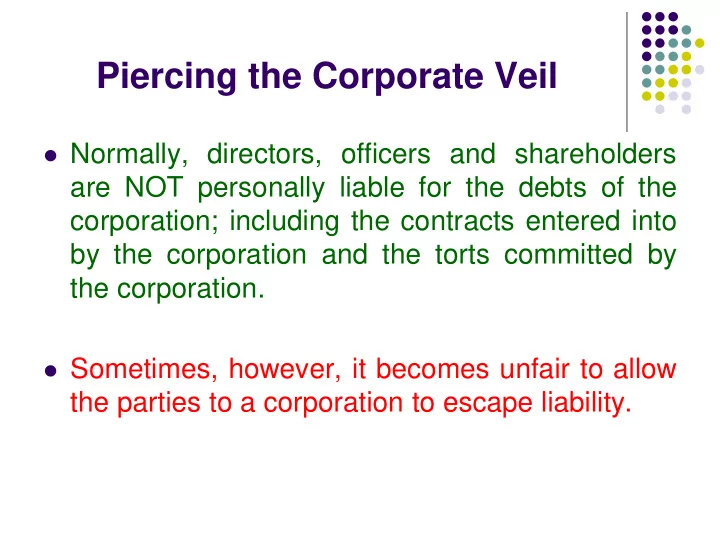

Piercing the Corporate Veil Normally, directors, officers and shareholders are NOT personally liable for the debts of the corporation; including the contracts entered into by the corporation and the torts committed by the corporation. Sometimes, however, it becomes unfair to allow the parties to a corporation to escape liability.
Situations in which a court will Pierce the Corporate Veil Alter Ego: the company is small and closely held the entire driving force behind the corporation is a single person (or small group of people) the purpose of forming the corporation was the liability shield the conduct of the owner(s) has turned illegal or abusive commingling of assets is a big factor Hiding Wrongful Activity: Crime or fraud committed by an officer, director or shareholder in the name of the corporation for the officer, director or shareholder’s own personal benefit Note: standards vary from state to state in terms of how easily a court will pierce the corporate veil
Liability of the Shareholder (even when the corporate veil is not pierced) Close Corporations: Employees’ wages: Some states force some large shareholders to be personally liable for wages of employees Many states give employees strong liens on corporation property to secure their wages in case of insolvency of the corporation Interested or fraudulent transactions (“entire fairness” standard)
Liability of the Shareholder 2 Open Corporations: Shareholder has to pay back: Dividend or distribution that would render the corporation insolvent ; but only if the shareholder knew or should have known of the insolvency when the distribution was made! “Watered” stock : If a person receives stock from the corporation for less than it fair value (for whatever reason), the shareholder becomes liable to the corporation for the difference between what was paid and what it’s worth
The Shareholder Derivative Action This is when a shareholder wants to hold directors responsible for an action that hurt the corporation. Problem: The directors make the decisions on behalf of the corporation, so how can the corporation bring a suit against the directors Solution: The shareholders sue on behalf of the corporation
Parties to a Shareholder Derivative Action Plaintiffs: the complaining shareholders and the “corporation” itself Defendants: The complained against directors and the corporation again!
QUIZ TIME!
Procedure of a Shareholder Derivative Action First, the plaintiffs must present their claims to the board and give them time to fix it. (This requirement can be waived if the shareholders could show that this demand would have been futile.) If there are disinterested directors, they may form a committee to study the claims. The disinterested directors can adopt the suit on behalf of the corporation and continue the action against the other directors If they do not, the shareholders press forward as any normal civil action If the shareholder wins the suit, remedial action is taken against the offending directors and the shareholders who brought the suit will be compensated for his or her expenses in bringing the action
Recommend
More recommend